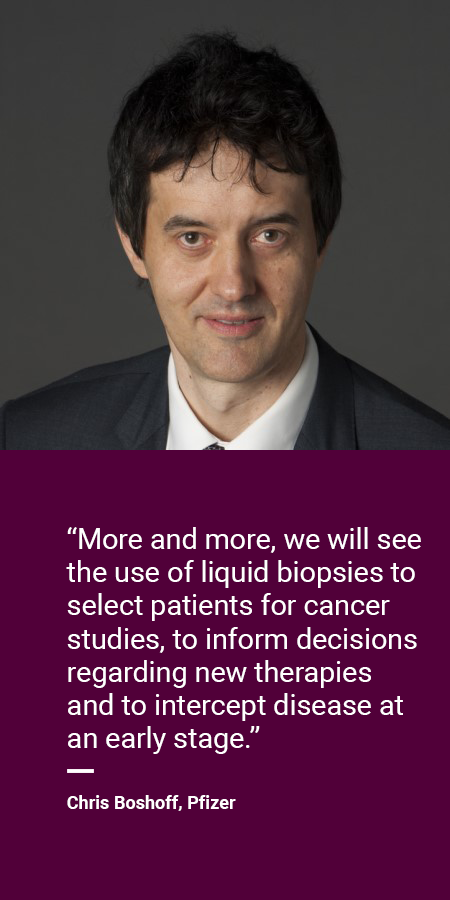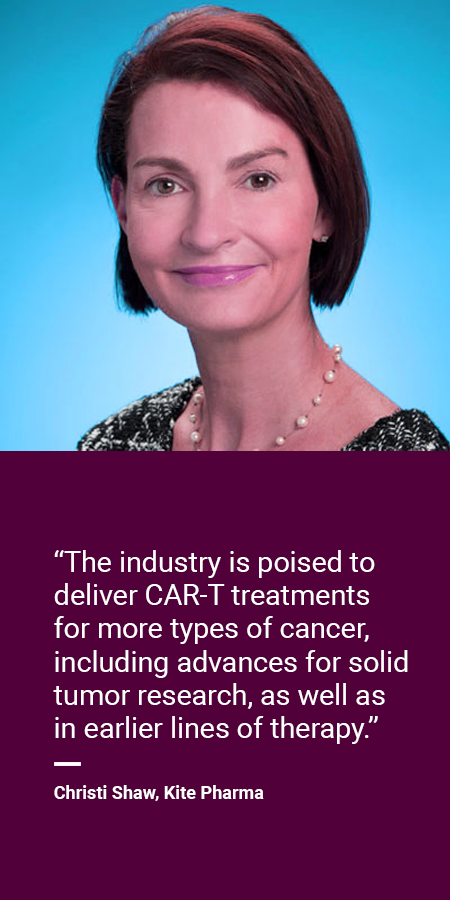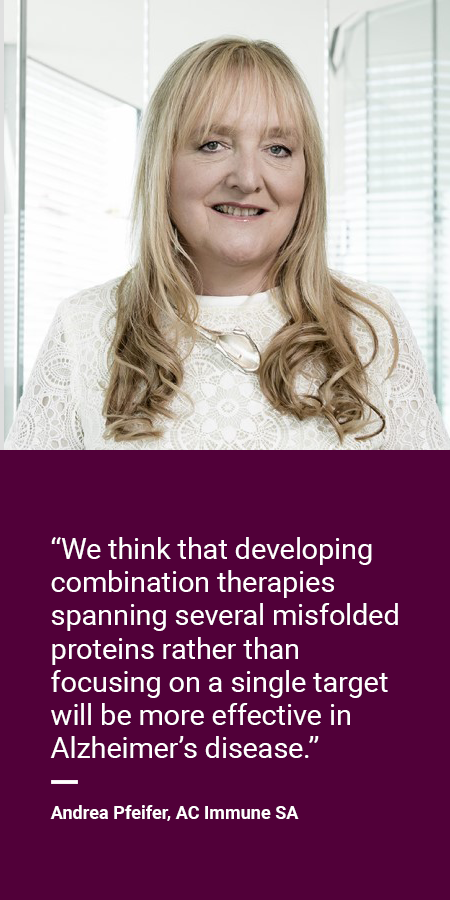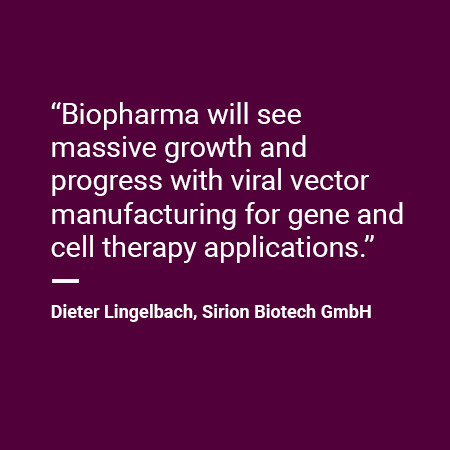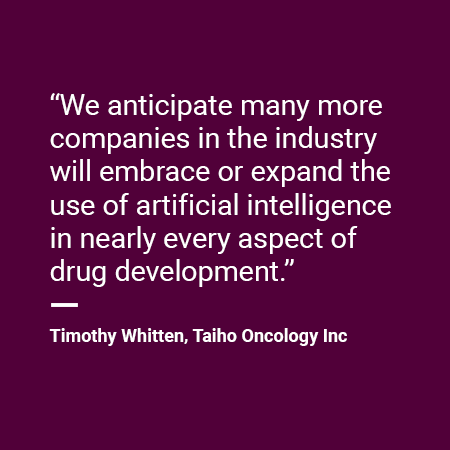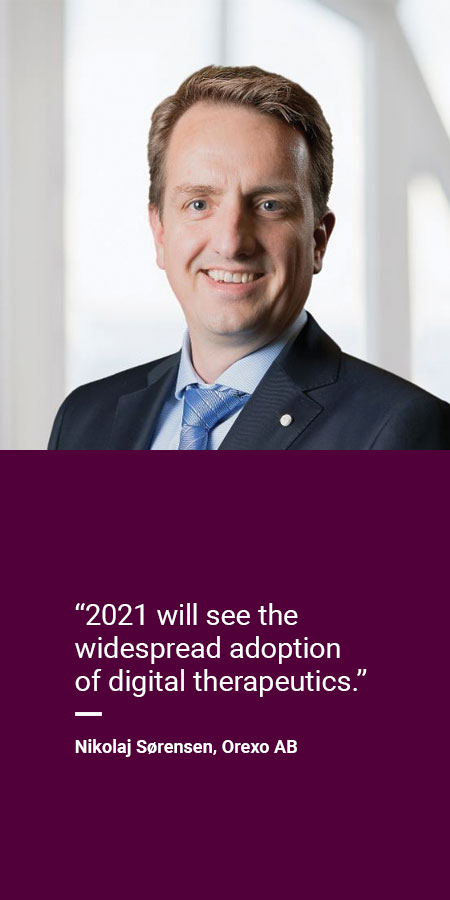Scrip Asks…What Does 2021 Hold For Biopharma? Part 4: Technology And Disease
Predictions From The Product Development Front Line
Executive Summary
Around 100 executives highlight the hot areas to watch on the R&D front in 2021. From cancer to CNS and from regenerative medicine to real world data, expectations are high on many fronts.
SCRIP ASKS…What Does 2021 Hold For Biopharma?
A broad survey of the industry’s expectations for the year to come.
Every December, Scrip asks industry leaders and experts to share their expectations for the year to come. With responses from more than 200 professionals, Scrip Asks…What Does 2021 Hold For Biopharma? provides an unprecedented insight into the biopharma universe’s collective crystal ball.
The full list of installments:
The biopharma industry has high ambitions to improve therapies for patients across many disease categories, drawing on a wealth of technological advances that have been emerging and maturing in recent years. Even after the mass mobilization against COVID-19, it is clear from the responses of the executives we surveyed that the sector has retained significant firepower to deploy across the disease spectrum.
“There continues to be a very exciting pipeline of innovations, launches coming up, and new disease areas that we can tackle, and new mechanism of action to bring more options to diseases that we have,” said PwC principal Greg Rotz.
“We will see the overall size of the R&D pipeline continue its inexorable expansion in 2021,” predicted Ian Lloyd, senior director at Informa Pharma Intelligence’s Citeline Pharmaprojects drug development database. “People might think that the COVID-19 pandemic knocked pharma R&D off its stride in 2020, but, aside from some temporary trial delays, I don’t think it’s had a hugely significant effect. The overall pipeline size grew by another 5.4% during 2020, although it’s true this was fueled in part by new drug developments against the novel coronavirus itself.
“Pharmaprojects reports over 500 drugs tackling the virus directly, over 300 vaccines, and over 250 drugs (some repurposed) tackling COVID-19-based complications – incredible when you think that the virus was virtually unheard of this time last year. I suspect that, especially if vaccine rollouts are successful, we will see some contraction in these numbers during 2021, especially in direct antivirals. But this will be more than compensated for by the ongoing surge in new developments for cancer and rare diseases, which will continue unabated.”
Emmanuel Hanon, senior vice president of vaccines R&D at GlaxoSmithKline plc, pointed out that drug development is being fueled by widespread technical innovation. “New technologies will continue to change the industry, increase the pace of discovery, manufacturing, and new innovative partnerships to further advance science and technology. I am excited about 2021 because we will be able to use a bigger and better toolbox of technologies for vaccines and pharmaceuticals than we have ever had, and we will be able to contribute to meeting one of the most extraordinary challenges of our times and build new capabilities coming out of it,” he told Scrip.
Identifying some of the hot areas to watch in 2021 was Jonathan Drachman, president and CEO of Neoleukin Therapeutics, Inc., which designs proteins to treat serious diseases. “Biotechnology and pharma will continue to see breakthroughs with emerging and new technologies in 2021, including mRNA and gene therapies, targeted protein degradation, and better, more precise regulation of the immune system. Oncology will see evolution as combinations of biological therapies offer the potential for long-term remissions in more patients with advanced cancer,” he said.
Lihua Yu, president and chief data science officer at Eisai Co., Ltd.’s precision oncology subsidiary H3 Biomedicine, told Scrip that oncology and rare diseases would remain core areas of focus “largely due to three factors: unmet medical needs; in depth understanding of disease biology and disease-defining and -driving genetic events; and our expanded access to different therapeutics modalities.”
Yu singled out protein degradation and CRISPR gene editing as hot topics. “If we look at bigger picture, the broad adoption of genomics looks very similar to the broad adoption of internet in the past 25 to 30 years,” she told Scrip. “It plays a foundation and platform role to allow transformative innovations to happen quickly and broadly…If you combine genomics and disease insights enabled by genomics, expanded therapeutic modalities, and digital transformation including machine learning and artificial intelligence, you come to the realization that transformative innovations are happening across all parts of biopharma industry value chain. In 2021 and beyond, we will continue to see new ventures in all those areas. I am also looking forward to see new cases of clinical translation and validations of the new disease insights and new therapeutic modalities.”
We have organized the predictions of nearly 100 industry leaders according to disease area, technology type and other themes.
Click on the cards to read more predictions from industry leaders.
Oncology
Reflecting the huge level of activity and investment in cancer R&D, oncology was once again the leading therapeutic area in terms of future expectations. “Next year will be especially good for patients as new therapies reach the market, especially in the immune-oncology field, with more checkpoint inhibitors, personalized precision medicines for patients, CAR-T, NK cells, and more,” said Jim Woody, CEO of inflammation-focused drug developer 180 Life Sciences.
Getting more granular detail about patients and their tumors was one recurring theme.
"While COVID-19 stopped a lot in its track, it did not stop cancer,” said Douglas VanOort, CEO of NeoGenomics, Inc., which specializes in cancer testing services. “There are continual challenges for people newly diagnosed with cancer, undergoing treatment, or monitoring for residual disease. Delays in seeking care due to the pandemic adds to the challenges and may result in more cancer patients presenting with later stage cancers than before. As we move into a new year in 2021, precision medicine will hopefully take on an even greater role in treating cancer with more and more targeted therapies for patients."
Chris Boshoff, chief development officer at Pfizer Oncology, also underlined the trend towards better targeting. “More and more, we will see the use of liquid biopsies to select patients for cancer studies, to inform decisions regarding new therapies and to intercept disease at an early stage,” he said.
Going into further detail, he added: “Expansion of the use of liquid biopsies, that detect either circulating tumor DNA (ctDNA) or methylated DNA fragments from blood plasma, has the potential to transform cancer medicine. With increased sensitivity, ctDNA detection could allow us to identify cancer earlier and potentially also dictate randomization to new treatments for M0 disease, which is disease that has spread as detected by molecular blood analyses, but not by conventional imaging. We plan to integrate liquid biopsies in studies initiating in 2021 for M0 breast cancer. These studies could inform the development of our portfolio of next-generation CDK inhibitors for hormone receptor positive breast cancer.”
“Targeted therapy has been a powerful force in the fight against cancer, but cancer is dynamic and resistance to treatment inevitably emerges,” warned Kate Haviland, chief operating officer, Blueprint Medicines Corporation. “In 2021, there will be a resurgence of precision therapy advances designed to overcome treatment resistance, or prevent resistance through combination strategies, with the goal of maximizing and prolonging patient benefits. These innovations will be driven by scientific advances that enable us to create exquisitely selective and potent drugs, as well as improved diagnostics and access to testing that help us better understand the biology of resistance, opening up a whole new range of druggable targets. With these advances, I am confident we will be able to respond to cancer’s evolution and stay one step ahead of the disease.”
“Despite the huge innovation in cancer immunotherapy over the past decade, currently only a minority of patients realize durable benefit from existing checkpoint therapies so there remains a huge need to develop more effective options,” said Markku Jalkanen, CEO of immunotherapy-focused Faron Pharmaceuticals Oy. “Our growing understanding of how the tumor microenvironment (TME) shields a cancer from the immune system and fuels its growth – including so called ‘don’t eat me’ signaling – makes it a clear target for the next generation of immunotherapies and we are likely to see further clinical data from a number of companies in 2021.”
He elaborated: “The tumor microenvironment is often characterized by high levels of infiltrating myeloid cells including monocytes, macrophages, dendritic cells, and granulocytes. These cells perform a variety of functions in the TME, varying from immune suppressive to immune stimulatory roles. There is a lot of myeloid-focused research now underway looking at how we can convert such cells from being highly immunosuppressive to immune-stimulating and more global pharma companies are entering the field.
“Faron’s own clinical program for bexmarilimab, our novel precision cancer immunotherapy that targets the Clever-1 receptor on positive tumor-associated macrophages, which has been expanded on the back of positive efficacy signals, has broad potential across a range of cancer types as a monotherapy and in combinations. I’m hopeful we will see significant data from that program and others in the field in 2021.” Other companies working on overcoming tumor immune evasion include Gilead Sciences, Inc. with the anti-CD47 agent magrolimab, acquired through its $4.9bn purchase of Forty Seven Inc. last year, and Merck & Co., Inc. with MK-4830, a first-in-class antibody targeting the myeloid-specific ILT4 receptor. (Also see "Gilead Calls Forty Seven Buyout Complementary To Kite, Other IO Efforts" - Scrip, 2 Mar, 2020.)
Many industry executives homed in on immuno-oncology (IO) targets for which they expect progress in 2021.
Michel Detheux, president and CEO of iTeos Therapeutics Inc., a cancer immunotherapy developer that listed on NASDAQ in 2020, noted: “The immuno-oncology space has made huge advances this year with exciting data on next-generation IO targets, TIGIT and A2A, presented at ASCO and AACR meetings, and we expect to step-shift progress in the IO space in 2021. These advancements in IO, particularly the development of drugs in the TIGIT and A2A space, will target a broader range of cancers, and ultimately reach more patients in need – it is an exciting area and we look forward to hearing the wealth of data expected in the next year that will continue to validate these promising fields.”
“There are several new immune targets in oncology, like those that target CD155, that are gaining scientific recognition,” said Matt Stober, president and CEO of Istari Oncology, Inc., which is developing a therapy to trigger the immune system to fight cancer.
“2021 will reveal the true potential of novel immunotherapies to transform the outcome of patients with certain hematological malignancies,” forecast Pfizer’s Chris Boshoff.
“The appropriate sequencing and rational combinations of bispecific antibodies and CAR-T therapies that target B-cell maturation antigen (BCMA) and other antigens in multiple myeloma have the potential to transform outcomes for patients. The continued development of breakthrough treatments, specifically with bispecific antibodies targeting BCMA, is an exciting and fast-moving area where we will see great advancements in 2021. Pfizer is looking forward to launching new registration-enabling studies for our subcutaneously administered BCMA-CD3 bispecific antibody in 2021, including those as monotherapy and combination studies.”
“For cancer patients, more breakthroughs are on the horizon,” predicted Christi Shaw, CEO of Kite Pharma, Inc., Gilead Sciences’ cancer immunotherapy subsidiary. “Specifically in CAR T-cell therapy, the industry is poised to deliver treatments for more types of cancer, including advances for solid tumor research, as well as in earlier lines of therapy – potentially bringing this promising therapy to more patients.”
Others also expected immunotherapy approaches that have made headway in liquid tumors to see advances in solid tumors.
“In oncology, cell therapies will begin to make a real impact in solid cancers – there will be energy around autologous and off the shelf approaches focussing on common tumour antigens,” said Houman Ashrafian, a managing partner with venture capital firm SV Health Investors, based in London in the biotech team.
Martin Lehr, CEO of cancer drug developer Context Therapeutics, has his money on BioNTech SE – which developed one of the first approved COVID-19 vaccines, using mRNA technology – to show progress in this field. “I predict that there will be a CAR-T breakthrough in solid tumors. While there are many programs going after established targets including HER2, MUC1, mesothelin, and folate receptor, I have my eyes on novel targets. In particular, the Claudin-6 CAR-T, BNT211, from BioNTech is really exciting, Given the roll BioNTech is on, I think it is hard to bet against them!”
Steven Katz, chief medical officer of TriSalus Life Sciences and a practising surgical oncologist, was also “enthusiastic about the progress that can be made in the use of immunotherapy to treat solid tumors.”
He said: “Industry and academia are more fully embracing the notion that solid tumors present distinct biologic challenges in relation to the application of immunotherapy, in sharp contrast to hematologic malignancies. An increasing number of combinatorial approaches are being tested to not only directly control tumor growth, but favorably modulate the immune environment within which solid malignancies thrive. Integration of innovative drug delivery solutions may further advance solid tumor immunotherapy. With so many promising cellular therapeutics, checkpoint inhibitors, and other immune-oncology agents under development, the field is poised to advance the care of solid tumor patients through multi-faceted strategies.”
Mark Erlander, Cardiff Oncology, Inc. CEO, was hopeful that advances would be made for “difficult-to-treat cancers like KRAS-mutated metastatic colorectal cancer (mCRC) … There are numerous biotech companies using the latest advancements in science to help patients with this aggressive type of cancer in a way we’ve not seen before. We’re proud to be a part of this effort at Cardiff Oncology, where our innovative approach is to target and inhibit an enzyme that is overexpressed in most cancers and part of a critical pathway that allows tumors to grow. Combining our investigational drug, onvansertib, with current standard-of-care to treat mCRC and other difficult-to-treat cancers, is rooted in deep scientific rationale. I anticipate that we will continue to see advancements involving this type of scientific rationale that is allowing tumor proteins to be targeted like never before. I believe this will yield unprecedented efficacy in hard-to-treat tumors. The innovation will surely translate into a win for patients.”
Daniel O’Connor, OncoSec Medical Incorporated CEO, thought there would be progress in making more tumors amenable to checkpoint inhibition. “While checkpoint inhibitors benefit a subset of patients, the majority of patients treated with them do not see an anti-tumor response because their ‘cold’ tumors lack the immune cells necessary to render them susceptible to cytotoxic T-cell attack. There will likely be a continued focus on the further development of solutions that can change an immunosuppressed ‘cold’ tumor into a ‘hot’ tumor to help patients who would not otherwise benefit from checkpoint therapy. Additionally, I anticipate a rise in partnerships between key players for combination approaches, as well as the development of drugs with unique mechanisms of action to improve clinical outcomes while limiting unwanted side effects and toxicity.”
“We expect to see growth in partnerships, new technologies in IO, including optimal engineering (eg Fc enhanced AGEN1181) and optimal combinations for anti-tumor immunity, including combinations of antibodies and cell therapy,” said Jennifer Buell, president and chief operating officer of immuno-oncology firm Agenus Inc.
“In the past few years, medicine has reaped the benefits of understanding the intricate dialog between anticancer antibodies and the innate immune system as illustrated by cellular immune checkpoint inhibitors," said Martin Welschof, CEO of Swedish cancer immunotherapy developer BioInvent International AB. “With deeper insights into the balance and control mechanisms that determine the outcomes of antibody treatment for individual patients, oncology will see much more emphasis on clinical trials of combinations of biological drugs as synergistic therapies.”
Lara Sullivan, Pyxis Oncology CEO, shared the hope that combining approaches would offer fruitful avenues for exploration. “Antibody-drug conjugates (ADCs) and immunotherapies have the potential to transform the cancer treatment landscape. The maturation and refinement of technology coupled with advancements in bioinformatics has enabled the identification of promising targets and primed the entire field for new developments. In 2021, I anticipate that many will realize the potential of bringing together ADCs with the continued power of harnessing the immune system and that leveraging both approaches may dramatically impact cancer treatment paradigms as more of them enter the clinic.”
Mark Enyedy, president and CEO, ImmunoGen, Inc., also flagged up the level of innovation around ADCs, noting “multiple recent approvals and transactions and a significant number of additional ADCs approaching late-stage, pivotal results, or key regulatory decisions in difficult to treat cancers.”
Several other avenues being explored in cancer R&D were also mentioned.
“We live in the golden age of biology, and this will continue for the foreseeable future and extend into all therapeutic areas, particularly oncology,” said Norbert Bischofberger, president and CEO of Kronos Bio, Inc. “We are pioneering a new way of discovering therapies that target the cellular networks that drive cancer, which have been historically challenging to target. We believe our distinctive approach will potentially help us get treatments to patients faster and more efficiently.”
“2021 will be the year of deepening our understanding of cancer biology and how best to leverage this knowledge to develop improved and novel treatments. In particular, I think that there will be a step change in our ability to analyse and elucidate the role of changes in non-coding DNA regions on the tumor, ultimately leading to a new generation of therapeutics,” predicted Michael Anstey, a partner at venture capital firm Cambridge Innovation Capital.
“I predict that we’re headed for the year of small molecule cancer therapies – both on the discovery and development fronts,” said Troy Wilson, president and CEO of Kura Oncology, Inc. “With targets such as the RAS proteins now shown to be druggable, we will continue to see innovation directed at therapeutic targets such as SHP2, MYC, YAP/HIPPO and others, which will provide clinicians with various tools to improve the lives of patients.”
Meanwhile, there remains a need for less toxic therapies. At G1 Therapeutics Inc., the new CEO, Jack Bailey, was looking forward to an FDA decision on the company’s investigational myelopreservation therapy trilaciclib, a CDK4/6 inhibitor designed to “fundamentally improve the experience and outcomes” for cancer patients treated with chemotherapy.
“Radiotherapy is a key therapeutic modality for several cancers but is limited by toxicities to surrounding healthy tissues and inherent tumor radio-resistance,” said Mel Sorensen, president and CEO of Galera Therapeutics, Inc., which is developing small-molecule dismutase mimetics to address these limitations and improve both sides of the therapeutic index. “We are conducting randomized, controlled trials in head and neck, lung, and pancreatic cancers. Galera’s lead compound, avasopasem manganese (GC4419), has breakthrough therapy designation for its first indication, severe oral mucositis in head and neck cancer, and the Phase III trial is expected to read out in 2021,” he said.
Also working on improving radiotherapy is TAE Life Sciences, whose CEO Bruce Bauer told Scrip: “We believe that boron neutron capture therapy (BNCT), an advanced particle radiation therapy technique that offers noninvasive treatment options for cancers of the head and neck, brain tumors and other aggressive and recurrent cancers, has the potential to change the world of cancer therapy and we anticipate reaching critical milestones in 2021. The new era of accelerator-based BNCT (AB-BNCT) has the potential to improve survival for patients with aggressive cancers while sparing healthy tissues and reducing the amount of treatments to only one or two.
“The efficacy of AB-BNCT is driven from the development of new boron drugs that aim to improve targeting, increase accumulation and longer retention of the boron in cancer cells.
“This potent biologically targeted radiation therapy is now approved in Japan for head and neck cancers and we expect completion of our first installation of a BNCT System in China this coming year with clinical trials starting in the second half of 2021.
“This is the first next-generation BNCT solution that includes both innovative drugs for biological-targeted treatments and a treatment delivery system. We also expect to see installations in the US as hospitals see the benefits of delivering biological-targeted drugs combined with the power of particle radiation. We are killing cancer cells from the inside out. We look forward to 2021 as we continue on the path to deliver the next standard of care for cancer.”
Peter Lebowitz, global oncology therapeutic area head at Janssen Pharmaceutical Cos., offered a fittingly ambitious conclusion to our section on oncology predictions: “I believe that 2021 will be the year when biopharma renews the commitment to get to cures in oncology. With novel technologies and highly actionable science, the time is ripe to develop anticancer regimens with curative intent. With data science, the time is now to approach cancer biology with better focus. With cancer interception, the world is ready for us to change the paradigm in order to eliminate of disease.”
CNS
“Looking to 2021 and beyond, I believe we will see growth in the central nervous system therapeutic arena due to macro and societal drivers, such as the global rise in the incidence of mental illness and the aging of the population, particularly in western societies,” said Stefan Weber, CEO of Newron Pharmaceuticals S.p.A. “I’m optimistic that this will be a year of new developments in this field, particularly in the areas of schizophrenia and Parkinson’s disease, two intractable indications that have seen little innovation over recent years.”
Les Funtleyder, health care portfolio manager at E Squared Capital Management, also singled out CNS as an area of interest. “There seems to be a lot of news flow coming in from CNS land. The pipeline is very interesting, there are gene therapies, other things in mental health areas like schizophrenia and bipolar disease. There do seem to be a number of very interesting compounds coming out, and we are positive on that sector.”
Robert Tansley, a partner at Cambridge Innovation Capital, is another investor watching the space. “2021 will bring novel understandings on the biology of neurodegeneration to stimulate investment for much needed therapies,” he said. “There are enough hopeful novel targets to dissipate some of the painful memories of failed approaches while the personal and societal impact continues to expand.”
And SV Health Investors’ Houman Ashrafian also fancies the CNS area for its growth prospects. “2020 was an interesting year for dementia therapy and there is likely much more to come over the next few years as the innovation matures,” he specified.
“Central nervous system therapies have lagged behind other areas of drug development for more than 30 years, leaving a large unmet need and an even larger business opportunity. New and innovative use of biomarkers will take the guesswork out of CNS development to improve the success of the development of drugs for these difficult diseases,” predicted Raymond Tesi, president, CEO and acting chief medical officer of INmune Bio, Inc., a company developing immunotherapies for cancer and Alzheimer’s disease. “The ‘derisking’ of CNS drug development combined with the declining opportunities in oncology will stimulate more companies to change their focus. We are entering the golden age of CNS drug development. Patients and investors will benefit.”
“We are being propelled by strides in science and medicine and digital health technologies, better diagnostic tools, and deeper data and insights, so that we can enhance CNS clinical development and ultimately new therapeutics for patients,” summed up Armin Szegedi, senior vice president and chief medical officer of Sunovion Pharmaceuticals Inc., which markets and develops CNS and respiratory products.
Praxis Precision Medicines, Inc. president and CEO Marcio Souza thought “CNS and especially mental health will be front and center as we adapt to new realities, and as an industry we will once again be able to take meaningful steps towards transforming the treatment landscape there. Focus on understanding the patients with the integration of genetics, more efficient clinical trial execution, and data at large, as well as leveraging expertise outside of the industry will drive a revolution in the field of precision medicines.”
Michel Pairet, head of Boehringer Ingelheim GmbH’s innovation unit, had a similar view: “2021 will bring a renewed focus on psychiatric diseases – an area that has been long underserved. Psychiatric diseases saw an insufficient scientific basis to support the discovery of new medicines. However, new developments in neurosciences, that are rationally investigating the link between specific symptom domains and brain circuits, are generating many promising new therapeutic concepts to treat psychiatric diseases.”
“I believe our industry will continue to build on biotech’s success in bringing innovations to market and reinvigorate efforts to address the toughest central nervous system challenges, like dementia, to bring new solutions to unmet needs,” said Steve Davis, CEO of neuroscience-focused ACADIA Pharmaceuticals Inc.
“In 2021, we might see a change to the pharmaceutical industry’s image of Alzheimer’s disease (AD). Like everyone in the field, we hope that Biogen, Inc.’s aducanumab will be approved and believe that the early indications pointing to limited benefits are the consequence of AD being a complex disease with a broad spectrum of underlying proteinopathies varying across individuals,” commented Andrea Pfeifer, CEO of AC Immune SA, which is also developing therapeutics for Alzheimer’s. “Our therapeutic strategy rests on the fact that, even though amyloid plaques and neurofibrillary tangles are AD’s hallmark biomarkers, the co-pathologies caused by aggregation of alpha-synuclein and/or TDP-43 should not be ignored. We think that developing combination therapies spanning several misfolded proteins rather than focusing on a single target will be more effective.
“As the contribution and timing of each co-pathology likely varies from individual to individual, there is still a need to develop targeted diagnostics. Our objective is to detect the different proteinopathies earlier, to chart disease progression and precisely measure the effectiveness of interventions. This precision medicine approach will enable a rational design and molecular basis for stratification of patients in treatment trials, ultimately resulting in an acceleration of our clinical development and a better understanding of the disease.”
Aniket Singh Rajput is CEO and founder of Neuroglee Therapeutics, which builds personalized evidence-based prescription digital therapeutics for neurodegenerative diseases. He sees other routes to success in Alzheimer’s. “In the coming year and beyond, we will see a reimagining of therapeutic solutions for neurodegenerative diseases such as Alzheimer's disease – especially when it comes to digital therapeutics (DTx),” he said.
“Currently, only five drugs have been approved by the US FDA to treat the symptoms of Alzheimer's disease, with the latest approval back in 2003. Although 121 drugs are in development to treat Alzheimer's disease, most are expected to produce only a mild to moderate effect on patients' cognitive functioning, behavior and other symptoms—underscoring the urgent need for adjunctive complementary therapies. That's where digital therapeutics will come in.
“We will begin seeing DTx that can be used with pharmacological therapy or as a standalone treatment, with a focus on slowing dementia-related cognitive decline. These solutions will employ engaging gamification techniques and cognitive tasks on a digital tablet so that patients' doctors can remotely monitor their cognitive function and intervene using personalized cognitive rehabilitation techniques. This may be one of the most exciting applications of DTx rolled out to date, given how great the unmet needs are for both patients and clinicians.”
Meanwhile, Cory Nicholas, co-founder and CEO of Neurona Therapeutics, highlighted the potential of regenerative medicine in CNS. “"In 2021, we’ll continue to see advances in the field of cell therapy beyond the application of CAR-T and other immune cell types for oncology. Pioneering work is being carried out in the development of regenerative neural cell therapies for diseases of the nervous system. This new wave of cell therapy 2.0 has the potential to be disease-modifying for chronic disorders that currently lack effective treatment options."
In the field of addiction, Achieve Life Sciences’ CEO John Bencich noted that COVID-19 had only underscored the importance of addressing chronic health conditions including smoking. “Achieve Life Sciences remains committed to the critical need for a new treatment option for smokers, and will continue advancing the development of cytisinicline for smoking cessation and nicotine addiction in its Phase 3 ORCA-2 Clinical Trial,” he said.
Also highlighting the need to tackle addiction was Roger Crystal, CEO and president of Opiant Pharmaceuticals, Inc. “The opioid epidemic, which claims the lives of over 130 Americans daily, has drastically intensified as the country also deals with COVID-19. CDC provisional data, published in September, reported an increase in fatal drug overdoses in the first three months of 2020, when compared to the year before; and most from opioids. This puts the US on pace for a record year of drug-overdose deaths during the ongoing coronavirus pandemic. The trajectory of America’s opioid epidemic is also rapidly evolving, fueled by the availability of fentanyl and related synthetic opioids. Since 2013, drug-overdose deaths involving synthetic opioids have increased ten-fold in the United States,” he warned. “In 2021, we must recognize that the nation’s opioid epidemic has grown into a much more complicated and deadly drug-overdose crisis and seek new interventions, treatments and protocols from biotech and the health care community to help save lives.”
Inflammation/Immunology
“We believe the inflammation and immunology indications are likely to provide continuing opportunities in 2021, with many diseases still underpenetrated with disease-modifying medicines, and many others still having no such treatments at all,” wrote SVBLeerink research analysts Geoffrey Porges and Charles Song in their 2021 Outlook report. They flagged as “key beneficiaries of the growing immunology market” AbbVie Inc. with its JAK inhibitor Rinvoq (upadacitinib) for rheumatoid arthritis and IL-23 inhibitor Skyrizi (risankizumab) for psoriasis, and partners Sanofi and Regeneron Pharmaceuticals, Inc. with their IL-4/IL-13 inhibitor Dupixent (dupilumab) for a growing number of indications, including atopic dermatitis and asthma.
They are not the only companies aiming to make the mark in the space. “As we enter 2021, it’s critical to have a frontier mindset on how we treat patients with some of the most debilitating and chronic conditions,” declared Ilya Yuffa, president of Eli Lilly Bio-Medicines. “In 2021, we’re going to reach new milestones for the millions of people living with chronic diseases such as atopic dermatitis, ulcerative colitis and alopecia areata so they can live a life without compromise.”
Bruce Steel, CEO of Equillium, Inc., underscored the scale of unmet medical need. “Nearly 4% of the world’s population are living with at least one autoimmune disease. There are more than 50 million patients in the US alone – at a cost of $86m a year – yet the gold standard in many of these 80 plus different autoimmune diseases are decades old anti-inflammatory agents such as prednisone, methylprednisolone, and dexamethasone. Emerging clinical programs and new discoveries revealing the underlying function of the immune system have attracted increased attention to anti-inflammatory agents, and the unmet medical need is staggering. There have been a few approvals in the last few years, but what is really exciting is what we see in clinical trials today, and the prospect of greater efficacy with stronger safety profiles in the near future.”
Equillium is developing its antibody treatment itolizumab for a number of severe immuno-inflammatory disorders. CSO Stephen Connelly added: “There have been recent breakthroughs in our understanding of the underlying biology of autoimmune and immune-inflammatory diseases, that affect more Americans than any other disease. We are already witnessing a large increase in the number of novel treatments in development that modulate, reprogram or bring renewed balance to the immune system, rather than bluntly suppressing its function to simply mask symptoms with a slew of unfavorable side effects. Understanding the biology of the disease in recent years has made an impactful change in drug discovery and is already starting to make a positive impact on patient’s lives.”
180 Life Sciences’ Jim Woody is particularly hopeful for diseases caused by autoantibodies. “With the likely launch of the anti-FcRn products from the five companies in play, we will be able to finally eliminate harmful, damaging autoantibodies that cause disease,” he said. argenx N.V. is awaiting US FDA approval for efgartigimod in myasthenia gravis; Immunovant, Inc., Johnson & Johnson, Alexion Pharmaceuticals Inc. and UCB S.A. all have anti-FcRn candidates in development too.
Cardiometabolic, NASH And Renal
“Among other things, the pandemic has underscored the importance of addressing the variety of chronic health conditions that increase the risk of poor outcomes in patients with COVID-19. Few would disagree that the coming year will give rise to new COVID-19 therapies and vaccines, but we will also see continued interest in new treatments that address these chronic conditions, including smoking, diabetes, heart disease and obesity,” said Achieve Life Sciences' John Bencich.
“The next generation of high purity omega-3 fatty acids have the potential to address several facets of cardiovascular risk,” commented John Climax, co-founder and CEO of Afimmune Limited, a biopharma company discovering and developing novel bioactive lipids. “I am looking forward to the TRIAGE clinical results with [Afimmune’s synthetic N-3 fatty acid] Epeleuton expected late 2021 which will tell us a lot more.”
“We believe that 2021 could see some significant steps forward for innovation in the renal space after a long period of stagnation,” said Joan Perelló, CEO of Sanifit. “Sanifit’s novel drug SNF472 for cardiovascular diseases linked to calcification in end stage renal disease is at the pivotal stage in its development and I’m excited to have the potential to be part of this new wave of breakthroughs in this area.”
There have been bumps in the road for the much-anticipated wave of new drugs to treat non-alcoholic steatohepatitis (NASH,) but the medical need remains. “NASH drug development is at a crossroads in 2021,” said Jonathan Young, chief operating officer and co-founder of Akero Therapeutics, Inc., which has a product for the condition in its pipeline. “The need is great for effective medicines to combat a disease that affects millions of people worldwide, is a leading cause of liver transplant and is associated with significant co-morbidities such as type 2 diabetes and cardiovascular disease. And there is tremendous promise in the next generation of NASH therapeutics in development, many of which are focusing on more holistic approaches to treating NASH such as FGF21 analogs.
“In 2021, we will see important data readouts for this class, including phase IIb biopsy results from Bristol Myers Squibb Company, and additional readouts from Akero and 89bio, Inc. on top of standout 2020 data.
“These bright spots have come in the context of several years of disappointing clinical results, including the complete response letter for obeticholic acid earlier this year. Increased uncertainty about potential for success in NASH has weighed on company valuations. One clear need for the drugs that eventually make it to market in NASH is the development of less invasive diagnostic tests so that patients are not forced to undergo invasive biopsies to access approved treatments. More positive data in 2021 could help build important momentum for noninvasive diagnostics and restore confidence in the potential for investigative NASH therapies to address a global disease with high unmet need.”
89bio’s CEO Rohan Palekar, also expressed optimism for the field in the coming year. “In 2020, we saw the power of what can happen when the biopharmaceutical industry comes together to address a health crisis. In 2021, I believe this collective momentum will keep pushing the industry forward as we continue to pursue solutions for ongoing health issues that existed prior to the pandemic. For example, diagnoses of non-alcoholic steatohepatitis (NASH) have been on the rise and are expected to increase dramatically in the next decade, yet there continues to be no approved treatment for this chronic and progressive disease,” he said. “We saw promising data for several investigational compounds for NASH in 2020, and I believe there will be more positive developments in 2021, bringing us closer to delivering the medicines that patients have been awaiting for far too long.”
Infectious Diseases
“A key trend that we expect to see in 2021 is a greater appreciation for continued research and investment in novel ways to prevent and treat infectious diseases,” said Jeffrey Stein, president and CEO of Cidara Therapeutics, Inc., which develops long-acting antifungal and antiviral treatments.
“According to the WHO, more than 40 new infectious diseases in humans have emerged in the past few decades. Importantly, the need for effective new drugs is not limited to viral infections but also includes those to address drug-resistant strains of fungi and bacteria. The current increased focus on preparedness efforts to prevent the spread of a wide variety of infectious diseases will continue in 2021. Prevention methods such as anti-infectives and vaccines are more important now than ever before, and the development and investment in novel approaches is compulsory to move forward.”
Michel Pairet, head of Boehringer Ingelheim GmbH’s innovation unit, also identified infectious disease as one of two areas (the other being psychiatric diseases) that would attract renewed focus in 2021. “The impact of the COVID-19 pandemic on the health and economy of our societies will increase the awareness for infectious diseases, not only to be prepared for the next global pandemic, but also to address the growing issue of antimicrobial resistance,” he told Scrip.
“The momentum around Covid-19 vaccines, small molecules and antibodies will continue, bringing a renewed vigour for the treatment and prevention of other infectious diseases including antifungals,” predicted SV Health Investors’ managing partner Houman Ashrafian.
Aging
Research around the possibility of influencing cellular senescence or eliminating senescent cells as a way of treating diseases of aging was highlighted by a number of executives. “This pandemic has really heightened awareness of different complications affecting the elderly. In the next decade, there will be a whole generation of COVID-19 survivors struggling with long-term complications such as cardiovascular and pulmonary disorders, with severe consequences especially in older individuals,” said Marco Quarta, CEO and co-founder of anti-aging firm Rubedo Life Sciences, Inc.
He went on: “The idea of therapies that purge the body of senescent cells, which accumulate with age and play a causative role in many age-related diseases, will see increased investor interest. Next year, we’ll see more preclinical and clinical data along with increased investments in different classes of senolytic agents, targeting different pathways for different age-related diseases.”
Thomas Rando, Fountain Therapeutics co-founder and chair, agreed that the field is advancing: “The field of aging research and therapeutics is accelerating rapidly and 2020 has introduced additional insights demonstrating that aging is the major risk factor of most chronic diseases and that it can be addressed therapeutically. This includes diseases that present significant burdens on our elderly population, including frailty, cardiovascular disease, dementia and even their susceptibility to COVID-19 infection.”
He forecast: “In 2021, we will continue to see emerging insights from this growing field which is entering a new era with unique medical, technological and societal implications. For the first time, we expect to see novel therapeutic candidates in the clinic to evaluate their potential to treat age-related health conditions by slowing or reversing cellular age.”
Anirvan Ghosh is CEO of another company developing treatments for diseases of aging, UNITY Biotechnology, Inc. He highlighted vision loss in particular. “The rapid growth of the aging population and the rise of diseases like diabetes in older people is contributing to a new blindness crisis, as the number of people suffering from vision loss is expected to triple in the next 30 years. Breakthrough medicines that block vascular endothelial growth factor (VEGF) activity have decreased the prevalence of blindness, but there still remains a significant unmet left by the limitations of anti-VEGF therapies,” he noted.
“In 2021, we will see a continued resurgence of innovative, new treatments that aim to address this growing need, which are largely pioneered by smaller biotech and biopharma companies. We’ll see a renewed interest in new modalities that focus on vascular health imbalances that are the root of age-related diseases and vision loss, such as emerging treatments that target the Tie2 pathway or cellular senescence.”
Cellular And Gene Therapy
The “continued breakout of regenerative medicine” was a trend for 2021 highlighted by Gil Van Bokkelen, CEO of Athersys, Inc. “There are about 100 promising cell and gene therapy programs that are in late-stage development, and we should see some exciting data from some of these this year,” he said.
Eric Ostertag, CEO of Poseida Therapeutics, Inc., concurred. “I believe 2021 will be another breakthrough year for cell and gene therapies. Advances in gene editing and gene delivery technologies will result in safer and more accessible treatments,” he said. “It’s an exciting time that will change the future of medicine, as we move closer toward developing single-treatment cures for patients with cancer and other serious diseases.”
“Despite the pandemic, 2020 brought a wave of innovation and investment in the regenerative medicine space, and I expect this to accelerate in 2021,” said Sandy Solmon, CEO of Celavie Biosciences LLC. “I’m also heartened by the FDA’s focus on hastening development of therapeutics for rare and orphan diseases, and feel it is important to maintain the provisions in the Orphan Drug Act so that development of new therapeutics can continue unfettered. These trends are bringing new hope to patients, and we are closer than ever to seeing the day when leveraging stem cells to restore function and even cure devastating genetic-based diseases becomes the norm.”
“Stem cell therapeutics will be a hot topic in 2021,” agreed Ross Macdonald, CEO and managing director of Cynata Therapeutics Ltd. “In 2020 the industry saw ground-breaking advancements, such as the initiation of the first Phase III trial of an iPSC [induced pluripotent stem cell]-derived MSC [mesenchymal stromal cell] therapy and several MSC therapies showing promise for the treatment of COVID-19.”
However, Macdonald acknowledged “challenges that will have to be confronted, such as the unexpected FDA rejection of the first allogeneic MSC therapy BLA to be reviewed by the agency, despite a positive recommendation from a panel of expert advisers. The FDA raised relevant concerns about manufacturing methods and product consistency, the latter being a particular challenge for conventional manufacturing processes that rely on multiple donors.” In October, Mesoblast Limited received a complete response letter for remestemcel-L in children with graft-versus-host disease. (Also see "Keeping Track: Disappointment For Mesoblast And Aquestive; Opdivo/Yervoy Add Mesothelioma Claim; Pediatric Approvals" - Pink Sheet, 2 Oct, 2020.) “The cell therapy industry will be looking to the FDA for further guidance in 2021 and manufacturing technologies that overcome the inherent challenges associated with conventional manufacturing of MSCs may gain more attention,” he noted.
Manufacturing issues were also flagged up by Manuel Litchman, president and CEO of Mustang Bio Inc. “We anticipate 2021 to bring continued improvements to the manufacturing process for autologous CAR-T cell therapies, and we anticipate challenges to the manufacturing processes of less well-validated cell therapies such as allogeneic CAR-T and NK cell therapies,” he said. “Developing these therapies is complex, and consistent and reliable production is imperative to ensure high quality and safe products get to each patient. We’re looking forward to the completion of our build-out of the clean rooms and labs at Mustang’s own manufacturing site in 2021 to facilitate the processing of CAR-T and gene therapies that address highly challenging diseases.”
Tara Clark, vice president of commercial business at the advanced technology solutions group Draper, also underlined the “urgent need for improvements in manufacturing” in the field of CAR-T cell and T-cell receptor (TCR) therapeutics. “Biotherapeutic companies are already evaluating their workflows, with particular focus on manufacturing efficiency and cost improvements intended to accelerate time to market and broaden patient access,” she said. “In 2021, Draper sees a growing need to deliver bioprocessing systems fit for today’s manufacturers – consisting of 21st century technology and adaptable as standalone units or combined end-to-end solutions – and deployable at the bedside or a centralized manufacturing facility. For even tighter manufacturing controls, some are making plans to add in-line biological sensing and machine learning capabilities.”
And Clark was among a number of industry leaders who anticipated progress beyond autologous cell therapy to off-the-shelf cell therapy: “In the future, there is a real possibility of allogeneic (off-the-shelf) products,” she added.
“In 2021, cell therapy will experience the first of five-plus years of explosive growth, especially in conditions for which small molecules or antibodies have failed, such as dry age-related macular degeneration,” said Brian Culley, CEO of Lineage Cell Therapeutics. “As these clinical-stage cell therapy programs march toward approvals, the commercial advantages of allogeneic approaches will combine with a growing body of safety data to drive higher valuations than seen for current autologous methods. In oncology, dendritic cells will enjoy a re-awakening in 2021 as a promising alternative to the continued expansion of CAR-T and NK cell therapies.”
Jakob Dupont, EVP and head of global R&D at Atara Biotherapeutics, Inc., also flagged up rosy prospects for allogeneic cell therapy and the expansion of the modality’s application beyond cancer. "With the maturation of cell therapy, we expect to see a coming of age from the early success in autologous CAR-Ts to off-the-shelf allogeneic therapies, coupled with other technologies, to address not only hematologic malignancies but also solid tumors and even non-oncology indications in autoimmune diseases such as multiple sclerosis,” he told Scrip.
Ying Huang, CEO and chief financial officer of Legend Biotech Corp., on the other hand, foresaw further mileage for currently approved CAR-T treatments. “The deep and durable responses that are characteristic of CAR-T cell therapies are expected to provide benefit to patients in earlier lines,” he said. “Further we are, as an industry, becoming more educated about managing the side effects of treatment, opening up the door for more widespread use.”
“With personalized cell therapies we can revitalize a patient’s immune cell reservoirs to combat hematological cancers. Next year will see a new phase for gene therapy: the first clinical evidence of its utility in the treatment of solid cancers,” predicted Carlo Russo, chief medical officer of Genenta Science srl. Sonny Hsiao, CEO and co-founder of Acepodia, Inc., and Geoff Hodge, CEO of SOTIO US, were also among those looking to cell therapies to demonstrate their potential in solid tumors after initial success in blood cancers.
“One major trend we’ll see in 2021 is the further development of cellular treatment options, such as chimeric antigen receptor (CAR) T-cell therapies for solid tumors,” said Hodge. “Cellular therapy has been very effective in hematological malignancies, such as blood, bone marrow, and lymph node cancers, but have been largely unsuccessful in solid tumors, due in part to the immunosuppressive microenvironment of the tumor. It will be interesting to see how the functionality of engineered T cells can be improved for efficacy in solid tumors. Next generation CAR-T therapies are fast approaching and will be a potential breakthrough treatment option for patients.”
“Despite incredible advancement in treatment strategies, solid tumors remain as an area of significant unmet clinical need, while representing nearly 80% of new cancer diagnoses,” said Hsiao. “Challenges, such as overcoming the tumor microenvironment among others, have prevented cell therapies from demonstrating significant efficacy in treatment and have served as a major barrier to successful clinical development. In 2020 we witnessed potentially transformative advancements in cell therapies, particularly the emergence of novel technologies and approaches that promise a new generation of clinical cell therapy candidates with the potential to overcome these long-standing challenges. While still evolving, we expect to see many of these programs enter the clinic and potentially even early signs of efficacy in 2021, which could change the treatment paradigm for these patients and elevate the therapeutic potential cell therapies beyond hematologic cancers.”
“For ex vivo therapies, we expect to see a growing focus on TCR therapies versus CAR-T to treat solid tumors. Beyond T-cells, we also think an arsenal of highly engineered immune effector cells, including NK cells and macrophage, will be critical to optimize immune cell therapy for oncology indications,” predicted Jak Knowles, chief business officer at Metagenomi, who also expects that 2021 will reveal a “growing cohort of companies in the cell and gene therapy space focused on in vivo gene editing. This will better enable curative treatments with potential for long term durable effects.”
“First-time approvals for gene therapies or gene-modified cell therapies will accelerate in 2021, compared with a slow 2020 during which only Gilead Sciences, Inc.’s CAR-T therapy Tecartus (brexucabtagene autoleucel) got cleared by the FDA in mantle cell lymphoma,” said Amanda Micklus, senior pharma consultant at Informa Pharma Intelligence. “We also saw the suspension of Orchard Therapeutics Limited’s Strimvelis from the EU market due to a disclosed case of lymphoid T-cell lymphoma associated with the therapy*. In 2021, at least nine BLA filings in the US and three MAA filings are expected across different cancers as well as rare diseases. Of particular note are anticipated BLAs for hemophilia B gene therapies from CSL Limited and Pfizer Inc./Spark Therapeutics, Inc. in the US, and the resubmission of BioMarin Pharmaceutical Inc.’s hemophilia A gene therapy Roctavian in the EU. The US and EU will also be watching for approvals of key CAR-T therapies ide-cel and liso-cel.”
While the field expands, Carsten Brunn, Selecta Biosciences, Inc.’s president and CEO, expects an emerging trend to come into focus. “The biopharma industry has overcome decades-old challenges for gene therapies in order to bring them to market over the last few years. Now that these therapies have evolved from science fiction to true medicines, I believe the biopharma industry will start to focus on the question of the long-term durability of these treatments, particularly considering the FDA’s concerns regarding BioMarin’s hemophilia A gene therapy this past summer,” he said.
“Gene therapy companies have been single-minded in their pursuit of creating safe and effective therapies, and the message has historically been that these are single-dose, curative medicines. Durability is of the utmost importance to patients and families who are likely to receive these therapies as children, and it’s essential that these treatments are developed with durability in mind. I believe we’ll see prioritization shift from safety and efficacy to safety, efficacy, and durability throughout 2021.” Brunn noted that: “At Selecta, we are excited to be a part of advancing this field with our ImmTOR platform. ImmTOR has the potential to enhance transgene expression at the first dose and make it possible to give patients multiple doses of a gene therapy throughout their lifetime, thereby potentially addressing declining expression and durability.”
Others focused on expanding the addressable pool of diseases. “In 2021 we hope to see a step shift in the genomic medicines field as innovative companies move to address the historical limitations of gene therapy to provide the treatments of the future. At SparingVision, we aim to harness the promise of genomic medicine to deliver new therapies for ophthalmic diseases, regardless of genetic mutation, taking a big step forward in 2021 as we commence our first-in-human trials for our mutation-agnostic treatment SPVN06 in retinitis pigmentosa,” said Stéphane Boissel, CEO and president of SparingVision.
Nawal Ouzren, CEO of Sensorion S.A., which is developing new therapies for hearing loss, pointed to future developments in deafness: “Gene therapies will start to expand into whole areas of medical endeavor that have largely defied conventional drug therapies. We have seen the impact of locally delivered biological and gene therapies in ophthalmic disease but we are now starting to see an increasing impact on deafness, too, starting probably with severe and inherited hearing loss.”
“New gene therapies are rapidly advancing in a number of disease areas that have not seen innovation in a number of decades,” summed up Matt Stober, president and CEO at Istari Oncology, Inc.
Meanwhile, just as cell therapy manufacturing needs to undergo rapid development, Dieter Lingelbach, chief business officer of Sirion Biotech GmbH, flagged up the expectation of manufacturing advances for gene therapies. “Biopharma will see massive growth and progress with viral vector manufacturing for gene and cell therapy applications. While many vectors have made it into clinical programs, creating true patient benefit requires overcoming the significant hurdles that remain in analytics, production yields and capacities, and patient treatment cost. In addition, we’ll see growth in the area of customization and manufacturing of viral vectors so we can expedite gene and cell therapy research and advance drug development, which became crucial throughout 2020.”
*Editor's note: this article was amended on 11 February 2021 to reflect the fact that Strimvelis has not been withdrawn in the EU, but its use has been suspended since October 2020 while an investigation into the cause of leukemia in a patient treated with the product is under way.
Other Advanced Genetic Medicines
In 2021, “targeting RNA will continue to be a source of great interest,” predicted Houman Ashrafian, managing partner with SV Health Investors.
For Chris Anzalone, CEO of Arrowhead Pharmaceuticals, Inc., “After 20 years of development, it appears that RNAi’s adolescence is finally over. Recent approvals have proved the technology is finally living up to its potential as a truly revolutionary and disruptive new class of medicines.
“I expect the RNAi coming of age story to carry into 2021 as our company and others in the space continue to mature. I also expect more interest from investors and other pharma companies seeking co-development and licensing deals. At Arrowhead, I am looking forward to continuing our work from the last few years to push the boundaries of where RNAi can go: outside the liver,” he said.
“2021 is poised to be a breakthrough year, especially in the area of delivery of a range of genetic medicines including mRNA, small RNAs, protein and even mixed payloads for gene editing applications,” said David Lockhart, CEO and president of ReCode Therapeutics, who also wants to go beyond liver-focused targets. “The most pressing need is to deliver these complex molecules to cells in organs and tissues beyond just the liver. Messenger RNA (mRNA) therapies in particular are poised to make a big impact in 2021. mRNA can now be designed for many purposes, made at scale and packaged in lipid nanoparticles (LNPs) for delivery to the body. Once inside cells, the delivered mRNA can instruct cells to make the encoded proteins, and this approach has become much more widely known thanks to the ground-breaking work of companies leveraging mRNA as a foundational element of COVID-19 vaccines. However, mRNA medicines, gene editing approaches and other genetic therapies continue to face the important challenge of how to deliver them to the right cells in the right tissues in the right amounts. And this has been particularly difficult in the case of delivery outside the liver, especially with systemic administration.
“Given the clear importance and the increased attention on these challenges, we expect to see great progress around delivery technologies that enable genetic medicines to be directed to organs and tissues in a predictable fashion. At ReCode, we are using a new breakthrough technology called SORT (Selective Organ Targeting) that allows us to “tune” the delivery of mRNA and other cargos encapsulated in our LNPs to previously unreachable organs, tissues, and cells types. We are very excited to be on the leading edge of developing these powerful delivery platforms, and using them ourselves to bring new therapies to patients with respiratory diseases including cystic fibrosis (CF) and primary ciliary dyskinesia (PCD).”
“Genome editing technologies have revolutionized the way we develop cell and gene therapies and regenerative medicines. However, in order to realize the promise of, and democratize, these highly innovative therapeutic approaches, the field needs to access novel RNA-guided nucleases and base editors that offer greater specificity and broader genome coverage. Researchers across the globe are working to expand upon the incredible work of Drs. Charpentier and Doudna who were awarded the Nobel Prize in 2020,” Mitchell Finer, CEO, LifeEDIT Therapeutics, told Scrip. “At LifeEDIT therapeutics we’re advancing a platform of RNA-guided nucleases with diverse PAM sequences derived from a microbial library used in agricultural applications. But we’re not alone in this quest to develop new technologies with more specificity that will allow researchers to tackle some of the hardest diseases facing our field. Companies like Beam Therapeutics Inc., Homology Medicines, Inc., Mammoth Biosciences, Inc. and numerous others are pioneering these exciting new technologies. 2021 is poised to see further explosion in the field of gene editing. Ultimately these new technologies will enable the industry to tackle some of the most challenging diseases, many of which have been intractable to date.”
“Be it specific to our own clinical programs, or across the biopharmaceutical industry in general, 2021 will bring about even more momentum on the development of new precision medicines that harness the vast potential of RNA interference (RNAi) to advance treatment options for chronic diseases,” said Mark Rothera, president and CEO, Silence Therapeutics. “Our own proprietary RNAi platform has yielded drug candidates for cardiovascular, hematological, complement-mediated, and other rare disease indications, and we look forward to sharing our progress in the year ahead.”
Targeted Protein Degradation
Describing targeted protein degraders as “the best thing to happen in small molecules since small molecules,” Nurix Therapeutics, Inc. CEO Arthur Sands noted they were “emerging as a major new class of therapeutic modalities. Building on ground-breaking science, progress is being made to generate clinical data to support their potential as therapies for a range of indications.”
“2021 will mark the 20th anniversary of the discovery of proteolysis targeting chimeras, or PROTACs for short. Since that momentous discovery the field of targeted protein degradation has exploded with nearly $3bn funneled into the field in the last three years,” said John Houston, president and CEO of Arvinas, Inc. “Over 15 companies have been founded to explore and develop this technology and numerous large pharma companies, such as GlaxoSmithKline plc and Roche Holding AG, are also working on programs using targeted protein degradation.
“In 2020, Arvinas was able to demonstrate the first clinical efficacy from its two lead programs, which are the first two PROTAC programs to enter human clinical trials. Moving into 2021, several more programs are poised to enter the clinic, further exploring the power and potential of this innovative technology across a wide variety of therapeutic areas. Additionally, targeted protein degradation is being explored for exciting areas outside of therapeutics. Oerth Bio is working to develop protein degraders for agricultural applications.
“2021 is likely to see significant additional clinical milestones proving out the technology, as well as continued investment and innovation in targeted protein degradation. It’s a perfect time to bear witness as a completely new modality comes to life. As you know, new modalities being born out are like 30- to 50-year storms in the industry. I’m looking forward to helping to advance this powerful platform in 2021 and watch it continue to evolve over the next 20 years.”
Meanwhile, Nello Mainolfi, co-founder, president and CEO of Kymera Therapeutics, Inc., said 2021 would “be the year Kymera provides early demonstration of the transformative clinical potential of targeted protein degradation, a truly game-changing modality, as we advance multiple programs to the clinic."
Vaccines
“This has obviously been a formidable year for the biopharma industry, particularly with respect to infectious disease and vaccine development. The global pandemic has accelerated the development and adoption of new vaccines that hold the promise to protect communities around the world, and it's been remarkable to see how rapidly programs have advanced in the vaccine space,” said Keith Rubin, founder and CEO of ILiAD Biotechnologies LLC. “At ILiAD, we continue to develop our intranasal pertussis vaccine candidate that recently completed Phase II studies with highly promising efficacy and safety data. We look forward to 2021 with enthusiasm and optimism as we continue to advance our pertussis vaccine program.”
Matt Stober, president and CEO at Istari Oncology, Inc., also expects vaccines to be an area of interest. “2021 is going to be a very interesting year for biologics, with everything from vaccines used to combat COVID-19, to vaccines like ours designed to trigger the immune system to fight cancer,” he said.
“We expect an increase in vaccine development and adjuvants will be a key part of this,” predicted Jennifer Buell, president and chief operating officer of Agenus Inc. “Immune boosting adjuvants, like Agenus’s QS-21 Stimulon, now approved in GlaxoSmithKline's SHINGRIX vaccine with over 90% efficacy, will be a critical component to drive and expand efficacy broadly.”
“Putting COVID-19 in the rear view mirror, virtuous viruses will show their promise in providing the backbone for treatments as far ranging as degenerative CNS disorders to immuno-oncology and vectorized antibody production will become more talked about,” predicted Philip Astley-Sparke, CEO and co-founder of Replimune Group Inc., which develops oncolytic immunotherapies that harness viruses to selectively kill tumors while inducing an anti-tumor response in the patient.
Drug Formulation
Chiasma, Inc. CEO Raj Kannan emphasized the growing importance of patient voice in therapeutic choices, “particularly the increase in patient preference for convenient, oral therapeutic agents in place of medically administered products.” Chiasma’s technology is applied to convert chronic injectable peptide therapies into oral medicines.
Brian Wong, president and CEO of RAPT Therapeutics, Inc. – which develops small molecules for cancer and inflammatory diseases – also thought there would be a focus on convenience over the coming year. “Drug development has always been focused on the ever-important and fundamental criteria of safety and efficacy to create a successful drug. A trifecta of benefit comes into play when your technology and platform is able to offer another patient-centric dimension: drug formulation and convenience,” he told Scrip. “In 2021, we’ll see more therapeutic options where one oral pill or tablet per day is used to overcome diseases from cancer and autoimmunity to neurological and cardiovascular disorders.”
Precision Medicine
“Life sciences will further advance digital transformation efforts to improve understanding of rare diseases and develop drugs that address niche conditions. To identify the right patients for targeted therapies, researchers will incorporate precision medicine techniques,” said Jane Reed, director of life sciences at Linguamatics, an IQVIA company and the provider of an agile natural language processing (NLP) text mining platform.
Several executives made predictions related to precision medicine, seeing it advance alongside developments in a range of scientific fields, from genomics to artificial intelligence.
Sirj Goswami is CEO and co-founder of InsightRX, a cloud-based clinical decision support platform that helps clinicians individualize treatment at the point of care.
“2021 will see an increase in precision dosing and monitoring of specialty drugs, particularly for drugs with narrow therapeutic indexes and high variability in drug response. We will also see pharmaceutical companies increasingly place an early emphasis on quantitative pharmacology during the drug development process for these drugs, as well as for cellular and gene therapies,” he predicted. “This is the evolution of an ongoing focus on reducing adverse drug events, which affect about 2 million hospital stays each year and add a cost burden of more than $30bn annually to the US healthcare system.”
Precision is expected to increase both in R&D and in clinical practice.
Marcio Souza, president and CEO of CNS-focused Praxis Precision Medicines, Inc., said: “Focus on understanding the patients with the integration of genetics, more efficient clinical trial execution, and data at large, as well as leveraging expertise outside of the industry, will drive a revolution in the field of precision medicines.”
“Across indications, we will see the trend towards a more systematic approach to integrating digital, data and diagnostics into fundamental drug discovery continue as well as patient stratification via systematic use of omics, especially ssRNAseq, in discovery,” said venture capital firm SV Health Investors managing partner Houman Ashrafian.
Paula Ragan, CEO and president of rare disease drug developer X4 Pharmaceuticals, pointed to the expansion of precise understanding of disease mechanism as a theme for R&D in 2021. “The increasing advancement of genomic tools has continued to help unveil our understanding of the genetic mechanism of many diseases, and thus potential novel therapeutic targets. A trend that I expect to continue seeing in 2021 is an increasing number of companies developing therapies that address the root genetic cause of many diseases, especially rare genetic diseases, to provide patients with the first ever disease-modifying therapies,” she said.
Artificial Intelligence
“As we move into 2021, look for the increased use of advanced AI-based technologies, such as natural language processing (NLP), to help life science companies efficiently leverage value from mass data sets. Researchers have access to a wealth of data from clinical records, scientific papers, social media, call center transcriptions and more. Using tools such as NLP, researchers can gain a deeper understanding of data and develop insights that advance drug discovery and development at all stages of the life cycle. The industry will continue to explore other digital tools to address new data challenges, such as the need for innovative data capture at the patient end during telehealth visits and ways to re-use captured data at the healthcare end,” said Linguamatics’ director of life sciences, Jane Reed.
“We anticipate many more companies in the industry will embrace or expand the use of artificial intelligence in nearly every aspect of drug development. This includes drug discovery, where deep learning has shown promise in reducing development times and progression to clinical trials initiation,” said Timothy Whitten, CEO and president of Taiho Oncology Inc. “AI has already demonstrated it can give clinical insight into the nature of a specific disease state and guide treatment decisions. These investments will provide real value and ultimately help the industry bring medicines to our patients faster than in the past.”
Pam Contag, CEO and co-founder of BioEclipse Therapeutics, Inc., also expects AI to make drug development more efficient. “The FDA, as well as the biotechnology and pharmaceutical industries will seek to accelerate product efficacy testing in the areas of rapid diagnostics and therapeutics earlier in their life cycles. We will come to use deep evaluation of successful trials with AI to help predict future success of therapeutics. This knowledge will be used for assessing the value to the market. A mechanism for new funding and strategies for product assessment among a greater number of technologies through the early stages will create a more precise and predictive understanding of safety risk and therapeutic benefit in each market."
“We are entering a new era where molecular science meets AI. Demand for personalized oncology care continues to expand worldwide, as patients and physicians seek to better understand specific cancer types and individualize treatment plans for better outcomes,” said David Halbert, chairman and CEO of oncology molecular profiling specialist Caris Life Sciences. “Caris is […] examining all 22,000 genes as well as the whole transcriptome, with an eye not just on what is relevant today, but that which will transform the management of cancer tomorrow.” He noted that by applying AI and machine learning systems, “vast amounts of clinical data can be efficiently analyzed to better understand each patient – and their cancer – leading to more informed, personalized and precise treatment plans improving the lives of cancer patients worldwide.”
Rose Higgins is CEO of applied radiomics firm HealthMyne. She pointed to the use of AI in interpreting medical images. “Precision imaging analytics technology, called radiomics, will increasingly be adopted and incorporated into drug development strategies and clinical trials management,” she said. “These AI-powered analytics will enable drug developers to gain deeper insights from medical images than previously capable, driving accelerated therapy development, greater personalization of treatment and the discovery of new biomarkers that will enhance clinical decision-making and treatment.”
Real World Data
“In 2021, the use of real-world data will continue growing as it becomes increasingly recognized by biopharma as critical information in the clinical trial process that can support the development and commercialization of new treatments. Patient-reported outcomes (PROs) that measure product efficacy and treatment effectiveness, as well as other domains of health and COVID-19, are helping the industry better understand the impact of the pandemic on the functional health and wellbeing on populations throughout the health care ecosystem,” said Gus Gardner, CEO of QualityMetric, which provides PRO measuring solutions to the pharma industry.
“Drug developers will use PRO throughout product development and commercialization, tracking patients to better understand the confounding impact of this global phenomenon in the real world. The use of patient registries to capture, curate and translate this data must also increase and bring the voice of the patient into the ‘learning health care system.’
“Beyond these extraordinary circumstances, PRO will continue to help developers of treatments for rare diseases, specifically, address major pain points: the poor understanding and mischaracterization of diseases’ natural histories; the fact that diseases tend to be life-limiting; and that small populations restrict study design and replication. We expect that drug developers will increase their use of PRO to document the etiology, progression, patient experience, symptoms and impact of rare diseases; and ultimately the treatment effect of novel interventions.”
Linguamatics’ Jane Reed additionally saw the use of real world data rising in the field of technology value assessment. “As an increasing number of new drugs enter the market, and as pricing and market access pressures continue to rise, life science companies will need to provide value-based assessments that use real world data to support drug access and product brands,” she said.
Digital Medicine
Kuldeep Singh Rajput is CEO and founder of Biofourmis, a Boston-based global leader in digital therapeutics and virtual care. He predicted: “In 2021, we will see digital therapeutics (DTx) increase their growth trajectory, including in areas such as:
-
DTx that will be prescribed in tandem with drugs that are difficult to titrate in order to reach guideline-directed medical therapy targets and optimal treatment dosages (eg, with heart failure drugs such as Novartis AG’s Entresto).
-
DTx prescribed to measure clinical signs of difficult-to-treat health issues that traditionally have relied on subjective reporting – for example, pain. Through the use of wearable biosensors, remote monitoring and AI-based analytics, physiological indicators of pain will be measured objectively, to better drive and optimize drug therapy.
-
DTx will increasingly be included in the drug development process, so that when the drug is approved and marketed, the DTx will be prescribed in tandem with that agent to optimize therapy and to enable software-based clinical interventions in between the patient’s face-to-face appointments with their doctor.
“2021 will see the widespread adoption of digital therapeutics,” said Nikolaj Sørensen, president and CEO of digital therapeutics company Orexo AB. “Digital health has proven to be a lifeline for many people during this year, particularly valuable in the substance abuse and mental health space. We look forward to the further roll-out and launch of such therapies, providing critical support where it is needed most.”
For Brent Vaughan, CEO of Cognito Therapeutics, Inc., which recently won breakthrough therapy designation from the FDA for a digital therapeutic to treat Alzheimer’s disease, the coming year will “see the rise of next-generation prescription digital therapeutics that advance from first-generation compliance/adherence devices and second-generation applied-CBT [cognitive behavioral therapy] products to the next evolution of digital therapeutics – that have drug-like effects. By this, I mean digital therapeutics that don’t just complement a drug or improve compliance, but actually function like a drug by improving efficacy and clinical outcomes by itself. Next-generation prescription digital therapeutics that have drug-like mechanisms of action and be able to demonstrate disease modification in chronic conditions such as Alzheimer’s disease.”
Decentralized Trials
"We expect to see an increased adoption of decentralized clinical trials (DCTs), also known as virtual clinical trials,” said Peyton Howell, executive vice president and chief commercial and strategy officer of Parexel International Corp.
John Reites, President of THREAD, a technology and service provider that enables decentralized clinical research, agreed. “2021 will be the year of the global decentralized clinical trial. After a year of unprecedented instability in the clinical trial space, 2021 is shaping up to be a transformative year for sponsors and CROs,” he forecast. “Decentralized clinical trial approaches, which have proven to be more sustainable in times of uncertainty, will take priority over traditional designs in 2021. Rather than adopting midway through the trial, as many did throughout the pandemic, studies will embrace DCT as their design of choice at the start of the planning process. As the industry aims to improve recruitment, retention, and data collection, there will be an increasingly heightened focus on trial flexibility and participant inclusivity. This focus will catalyze the industry’s inevitable shift to more global studies, powered by hybrid DCTs.
“2021 will be a pivotal year for the expansion of global studies as the viability of traditional trials continues to dissipate.”
Academic/Industry Partnering
The race to develop diagnostics, vaccines and therapeutics for COVID-19 in 2020 brought a proliferation of collaborative projects and demonstrated what can be achieved when many parties work at pace to address a health challenge. “2021 will challenge us to innovate,” said Leen Kawas, CEO of regenerative medicine company Athira Pharma, Inc. “The past year has led to an acceleration in advances across many areas, including in biotech and pharma, that will have long-term impacts. In the coming year, we should continue to see collaborative efforts to improve public health.”
“Academic institutions and biopharma companies have historically operated in drug research and development silos, coming together to collaborate for one-off transactions, where a piece of research moves from academia to industry. We’re starting to see that change now, as a growing number of companies join forces with academic institutions to establish long-term, mutually beneficial partnerships. I believe we’ll see even more of that in 2021,” said Michael Henderson, chief business officer of BridgeBio Pharma, Inc., which develops drugs against genetic diseases.
“From the fields of neuroscience to rare diseases, which tend to see less investment from biopharma, academics are making ground-breaking early discoveries that may solve some of our industry’s greatest challenges. It’s up to us to support this research and move promising findings off the shelves of academia and develop it for patients in need,” Henderson predicted.
“In an unprecedented year, we saw the power of what can be achieved when the biopharmaceutical industry comes together – from the development of a vaccine for COVID-19 to innovation in cancer and other challenging therapeutic areas,” said Percival Barretto-Ko, president of Astellas Pharma US Inc.
“In 2021, we can expect important advancements in how we address hard to treat diseases, as well as more partnerships, alliances, and increased collaboration across the industry.”
Additional reporting by Joseph Haas.


















